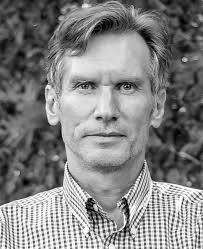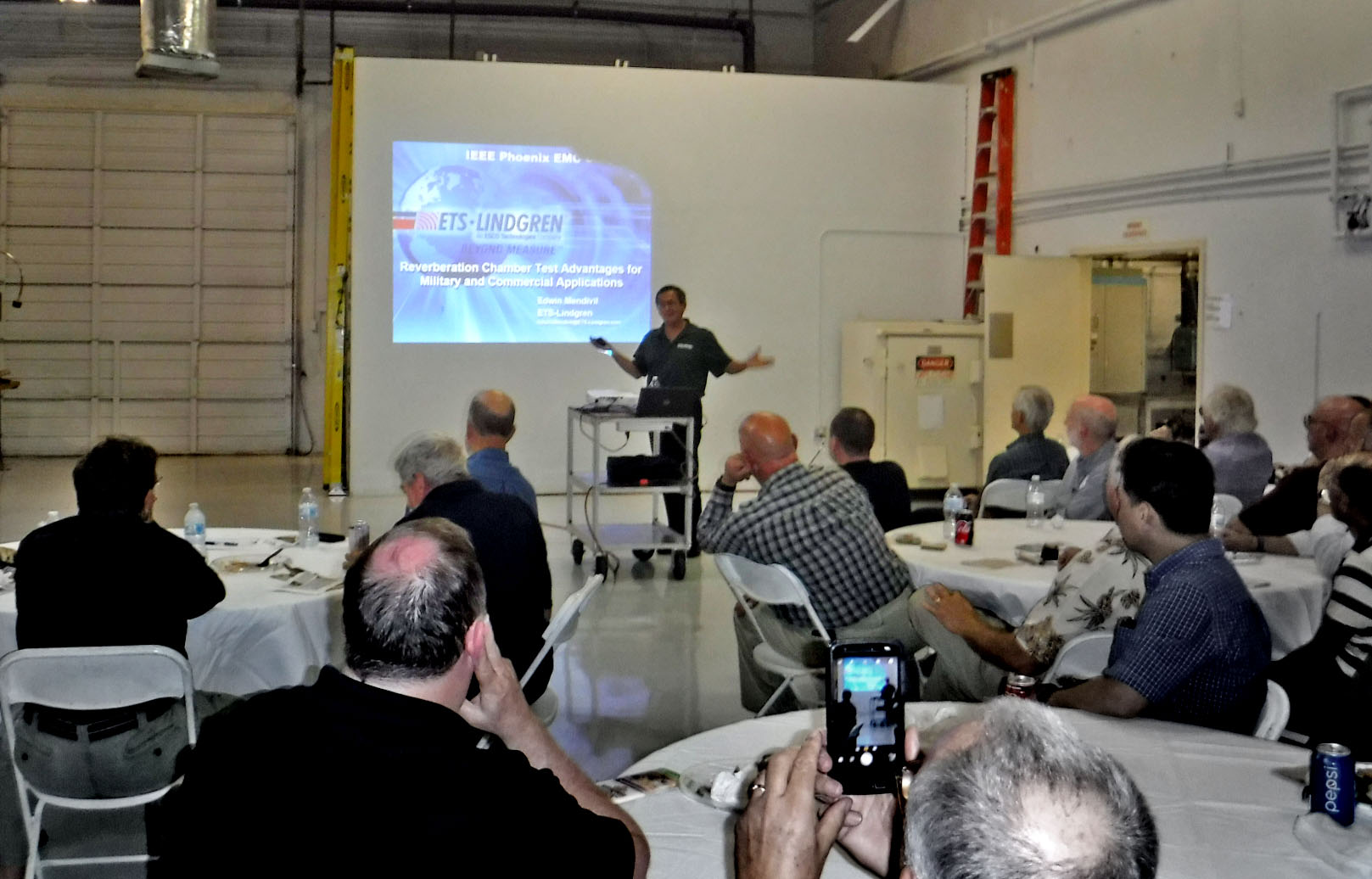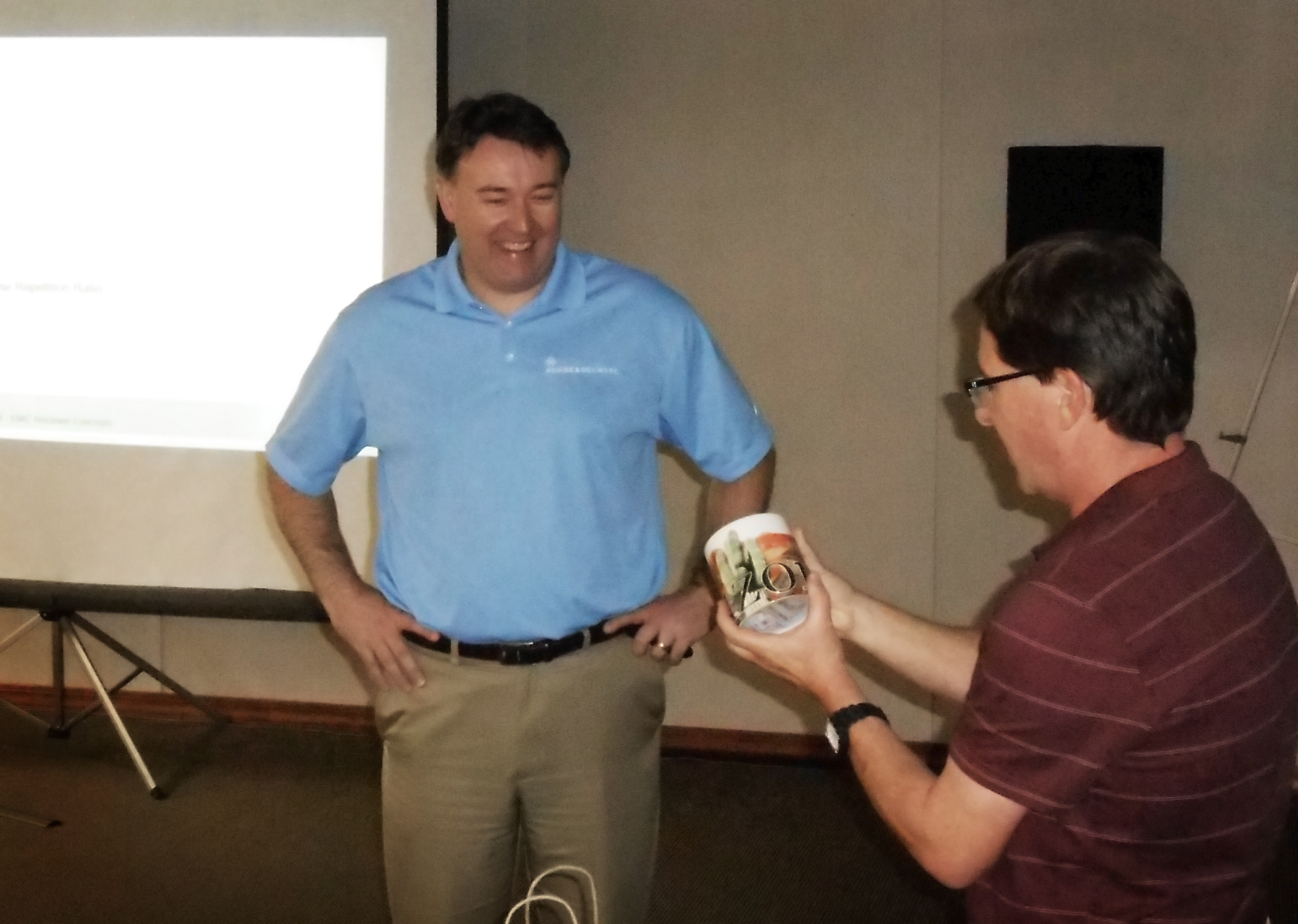2018 – 2019 Meeting Reports
A Basic Overview of RF/EMI Filters and Filtered Connectors
Date: Thursday, November 7th, 2019
Time: 5:30 PM: Networking, Dinner and Drinks (food and beverages provided)
7:00 PM: Presentation
Speaker: Bob Ydens, Senior Founding Engineer and President of EMI Solutions
Location: Compliance Testing, LLC
1724 S. Nevada Way, Mesa, AZ 85204
Phone 480.926.1775
www.compliancetesting.com
 Our first meeting of the 2019-20 season was held at Compliance Testing Labs in Mesa Arizona on Thursday November 7th. The evening began at 5:30 pm with the customary social hour and an excellent Mexican food dinner from Tempe’s Manuel’s Mexican Restaurant.
Our first meeting of the 2019-20 season was held at Compliance Testing Labs in Mesa Arizona on Thursday November 7th. The evening began at 5:30 pm with the customary social hour and an excellent Mexican food dinner from Tempe’s Manuel’s Mexican Restaurant.
The meeting itself began at 6:45, with Glen (our chapter chair) discussing chapter business. Glen asked the membership how the Eventbrite invitation system was working. Most member liked the new technique. Glen also announced that we will have officer elections early next year. We then did our customary around-the-room introductions.
Glen then introduced our featured speaker, Bob Ydens of EMI Solutions. Bob is the Senior Founding Engineer and President of EMI Solutions, headquartered in Irvine CA. With has spent over 35 years focused on Electromagnetic Interference technology. He presentation was titled: “A Basic Overview of RF/EMI Filters and Filtered Connectors”.
Bob talked about how and when to use C, L-C, C-L and PI filter connectors and filter inserts. The idea is the identify the capacitance of the filter to operate at the correct frequencies, select the capacitance so it doesn’t interfere with the intended signals, and to choose the optimum capacitance based on the -3dB cutoff frequency. A capacitor only” C” filter has the narrowest “Q” which is greatly impacted by it’s mechanical packaging. They are useful to stop a limited range of noise, but they have little high frequency performance. Filters that contain ferrite inductors operate over a much wider range.
It’s important to place a filter component where it will do the most good. Filter connectors are well-positioned as compared to internal filters, since they are at ideal location – at the enclosure wall.
Bob also spoke about the difference between discoidal and planar arrays. At one time, planar arrays had industry-wide issues with cracking caused by thermal cycling. Bob’s company uses spring clips or solder washers to overcome that problem.
Finally, Bob showed real-world radiated emission test data that illustrated his points. Broad emissions 15 dB above the specification limit were reduced using several topologies, showing how each worked. Eventually a 25,000-pF discoidal array was used to hold the emissions below the limit.
After the talk, Glen Gassaway thanked Bob for his fine presentation! The meeting was closed at 8:00.
We are grateful to Compliance Labs in Mesa AZ for hosting and providing their facilities for this event.
Download a copy of Bob’s presentation here:
November Meeting Photos
Antenna Fundamental Parameters and Figures-of-Merit
by: Constantine A. Balanis, ASU
5:30 PM: Networking, Dinner and Drinks (food and beverages provided)
6:45 PM: Presentation
Dr. Balanis will review of antenna fundamental parameters and figures-of-merit, which are used to describe the performance and radiation characteristics of an antenna. This is to include Radiation Density, Radiation Intensity, Beamwidth, Bandwidth, Directivity, Antenna Efficiency, Gain, Realized Gain, Polarization, Input Impedance, Effective Area, and others. Most of these are based on the IEEE Standard Definitions of Terms for Antennas.


Constantine A. Balanis (S’62 – M’68 – SM’74 – F’86 – LF’04) received the BSEE degree from Virginia Tech, Blacksburg, VA, in 1964, the MEE degree from the University of Virginia, Charlottesville, VA, in 1966, and the Ph.D. degree in Electrical Engineering from Ohio State University, Columbus, OH, in l969. From 1964-1970 he was with NASA Langley Research Center, Hampton VA, and from 1970-1983 he was with the Department of Electrical Engineering, West Virginia University, Morgantown, WV. Since 1983 he has been with the School of Electrical, Computer and Energy Engineering, Arizona State University, Tempe, AZ, where he is Regents’ Professor. His research interests are in computational electromagnetics, electromagnetic metasurfaces for RCS reduction, antenna beamforming and low-profile antennas. He received in 2004 an Honorary Doctorate from the Aristotle University of Thessaloniki, the 2017 IEEE MTT-S Rudolf Henning Distinguished Mentoring Award, the 2014 James R. James, Lifetime Achievement Award, LAPC, Loughborough, UK, the 2012 Distinguished Achievement Award of the IEEE Antennas and Propagation Society, the 2012 Distinguished Achievement Alumnus Award (College of Engineering, The Ohio State University), the 2005 Chen-To Tai Distinguished Educator Award of the IEEE Antennas and Propagation Society, the 2000 IEEE Millennium Award, the 1996 Graduate Mentor Award of Arizona State University, the 1992 Special Professionalism Award of the IEEE Phoenix Section, the 1989 Individual Achievement Award of the IEEE Region 6, and the 1987-1988 Graduate Teaching Excellence Award, School of Engineering, Arizona State University.
Dr. Balanis is a Life Fellow of the IEEE. He has served as Associate Editor of the IEEE Transactions on Antennas and Propagation (1974-1977) and the IEEE Transactions on Geoscience and Remote Sensing (1981-1984); as Editor of the Newsletter for the IEEE Geoscience and Remote Sensing Society (1982-1983); as Second Vice-President (1984) and member of the Administrative Committee (1984-85) of the IEEE Geoscience and Remote Sensing Society; and Chair of the Distinguished Lecturer Program (1988-1991), Distinguished Lecturer (2003-2005), member of the AdCom (1992-95, 1997-1999) and Chair of the Awards and Fellows Committee (2009-2011) all of the IEEE Antennas and Propagation Society. He is the author of Antenna Theory: Analysis and Design (Wiley, 2016, 2005, 1997, 1982), Advanced Engineering Electromagnetics (Wiley, 2012, 1989) and Introduction to Smart Antennas (Morgan and Claypool, 2007), and editor of Modern Antenna Handbook (Wiley, 2008) and for the Morgan & Claypool Publishers, series on Antennas and Propagation series, and series on Computational Electromagnetics.
Download a copy of Dr. Balanis’s presentation here:
Fundamentals of Power Integrity with Current Design & Analysis Practices
Thursday, November 15th, 2018
Speaker: Ihsan Erdin, IEEE EMCS Distinguished Lecturer
Location: Compliance Testing, LLC
1724 S. Nevada Way, Mesa, AZ 85204
Phone 480.926.1775
www.compliancetesting.com
SPEAKER BIOGRAPHY:
  |
Ihsan Erdin received the M. Sc. degree from Middle East Tech. U, Ankara, Turkey in 1993 and the Ph.D. degree from Carleton University in 2001, both in electrical engineering. From 1995 to 1996, he was a research fellow at Defense Research Development (DRDC) Ottawa. From 2000 to 2007, he worked as an SI/PI engineer at Nortel. Since 2007, he has been working in the same job function at Celestica Engineering Design Services in Ottawa. He is an adjunct faculty member with the Electronics Department of Carleton University since 2007. Dr. Erdin is a member of the Professional Engineers Ontario and a senior member of IEEE. He also serves as a member of Signal and Power Integrity Technical Committee (TC-10) of EMC Society. With numerous technical papers in peer-refereed journals, conferences and workshops, his research interests are analytical and computational methods in electromagnetics with application to printed circuits and multichip modules. |
Meeting Summary:
The fourth and final meeting of 2018 for the Phoenix IEEE EMC Chapter was held on Thursday, November 15, 2018. The meeting was held in the usual meeting location at Compliance Testing located in Mesa Arizona with more than 25 members/guests.
The social hour started at 5:30 pm with guest sign-in at the front desk of the meeting hall. Dinner started at 6:00 pm and was a Mexican food buffet with drinks of choice.
Glen Gassaway, chapter chairman, opened the meeting by providing information on the upcoming Phoenix IEEE EMC Symposium to be held in April 2019. Along with other activities, Daryl Gerke will present his well-known EMC class. Volunteers will be needed to help with this event. A reminder was also made to the attendees to be sure to sign the attendance sheet. Guests are urged to leave contact information as a way of keeping informed of local activities. As always, introductions where then made by all the attendees, a wonderful approach to getting information and making new acquaintances/friends.
Once Glen concluded the business end of the meeting, he introduced the guest speaker for the last meeting of the year, Ihsan Erdin. The topic for the evening was ‘Fundamentals of Power Integrity With Current Design And Analysis Practices’. A copy of the presentation was provided to the group through Glen.
The basic topic of the presentation was the placement of decoupling capacitance, a subject of concern for all EMI design engineers. But here, the discussion was geared toward large pin count components with complex power and reference pin grid arrays and the effects of spread inductance when the location of the decoupling is not optimized. Ihsan also discussed how this placement can be facilitated with algorithms he has developed.
This presentation was very well received based on the number of follow-up questions and comments at the end.
As we close out the year the local EMC chapter committee would like to thank those guests who attend regularly and those that we meet for the first time for helping us have successful meetings throughout the year. We look forward to another year with old friend and new acquaintances.
Reverberation Chamber Test Advantages for Military and Commercial Applications
(Presentation and Chamber Demo)
Tuesday, October 23rd, 2018
Speaker: Edwin Mendivil, RF Engineer, ETS-Lindgren, Cedar Park, Texas
Location: NTS Labs, 1155 West 23rd Street, Suite 11A, Tempe, AZ 85282,
By Edwin Mendivil, ETS-Lindgren, Cedar Park, Texas
  |
SPEAKER BIOGRAPHY: Mr. Edwin Mendivil is an RF Engineer with ETS-Lindgren, located in Austin, Texas. He has over 15 years of experience in OTA/SAR testing and measurements. Edwin received the B.M.S. degree in signals and telecommunications from Chorrillos Military Academy, Lima, Peru, in 1984, and the B.S. and M.S. degrees in electrical engineering from Florida Atlantic University, Boca Raton in 1994 and 1996, respectively. His Master’s thesis concerned the performance of ultrawide-band radars under clutter and stealth target environments. In 1996, he joined the Motorola Corporate Electromagnetic Energy (EME) Research Laboratory in Fort Lauderdale, FL, where he was involved in the development of software tools for the analysis and measurement of SAR. Edwin joined ETS-Lindgren in 2013, working primarily on the design of reverberation chambers. |
Meeting Summary:
Robert Windell reports that the third meeting of 2018 of the Phoenix IEEE EMC Chapter was on Tuesday October 23, 2018. In a break from the usual meeting location, this meeting was held at the National Test Services (NTS) environmental test facility located in Tempe. The chapter thanks NTS for hosting this event.
The meeting was attended by at more than 30 members/guests. The social hour started at 5:30 pm after checking into the lab facility guest sign-in kiosk. Dinner started at 6:00 pm and was a sandwich and salad buffet with drinks of choice and lots of pleasant conversion as old and new members had a chance to catch up on what was new since the last meeting. It was good to see several familiar faces from the Tucson area in attendance.
Glen Gassaway, chapter chairman opened the meeting by providing information on the upcoming IEEE EMC Symposium to be held in New Orleans, Louisiana from July 22nd to July 26th of 2019. Symposium brochures were handed out to the members and guests that provide all the information necessary to register. A reminder was also made to the attendees to sign the attendance sheet as this is the best way of keeping up with local contacts and interested guests. Introductions where then made by all of the attendees, a wonderful approach to getting information and making new acquaintances/friends.
Glen also took time to discuss our fourth and final EMC group meeting of the year to be held at our usual meeting location at Compliance Testing LLC on November 15. Glen will provide all the details in an email to those who are already signed up or new friends who signed the attendance sheet and provided email information. Once Glen concluded the business end of the meeting he introduced the guest speaker for the evening, Edwin Mendivil of ETS-Lindgren. Edwin’s topic for the evening was ‘Reverberation Chamber Test Advantages for Military And Commercial Advantages.
The topics discussed where
1. Basic RC Theory
2. RC characterization for LFF devices
3. RC characterization for MIMO testing
4. RC calibration for military applications
5. AGC: Automatic Gain (of Level) Control
This presentation was very well received and provided a very good introduction into reverberation chambers that was very well received by all as this type of testing is becoming more prevalent and more necessary. The discussion on chamber loading and how it is used was extremely interesting. A big thank you to Edwin for taking the time to share his passion and his knowledge with the group.
After the presentation a reverberation chamber demonstration was provided by Jim and the staff at NTS. This served to provide some real time experience for Edwin’s topics. The demo included a broadband noise source that was scanned across a fixed frequency range and then rescanned with chamber loading positioned near the source. Those who stayed for the demo could see the differences in the two scans on the spectrum analyzer. Jim and the NTS staff provided a follow up discussion on the effects of loading and how it is applied as well as discussions on chamber ‘Q’ factor. Thanks you NTS for your time and for sharing your knowledge and facilities.
A big thank you to NTS, ETS-Lindgren and the Phoenix chapter staff for a meeting well received by all in attendance.




Download a copy of Edwin’s Presentation here.
Modern EMC Receiver Measurement Concepts (3-20-2018)
The second meeting of 2018 of the Phoenix IEEE EMC Chapter was on Thursday March 20, 2018 at Compliance Testing Labs. The chapter thanks them for providing their conference room and facilities for this event.
The meeting was attended by at more than 30 members/guests with a very cordial social hour commencing at 5:30 pm. Dinner was a wonderful Mexican buffet with drinks of choice and lots of pleasant conversion as old and new members had a chance to catch up on what was new since the last meeting. Guests were joining in the table conversations as well.
The meeting began with some announcements from our chapter chairman, Glen Gassaway. He went over IEEE business including discussion on the benefits of IEEE membership for those who have not yet joined. Also discussed was the upcoming IEEE EMC Symposium to be held in Long Beach, California from July 30 to August 3 of 2018. Symposium brochures were handed out to the members and guests that provide all the information necessary to register. A reminder was also made to the attendees to sign the attendance sheet as this is the best way of keeping up with local contacts and interested guests. Introductions where then made by all of the attendees, a wonderful approach to getting information on work availability/needs.
After Glenn concluded the business end of the meeting he introduced the guest speaker for the evening, Bill Wangard. Bill Wangard is the EMC Receiver, Broadband Amplifier, and EMC Software product manager at Rohde & Schwarz USA. He took an active role in working with the Tri-Services Working Group to implement FFT based Time Domain Scan within MIL-STD-461G. Bill has 20+ years of RF and receiver design experience with Motorola and Rohde & Schwarz USA where he authored numerous white papers and patents. Bill’s topic for the evening was EMC Receiver Concepts. A copy of the presentation was provided to the group through Glenn.
Download (PDF, EMC-Receiver-Concepts_2018.pptx-3-20-2018.pdf)
Discussion topics included:
- What Does Compliance Mean
- CISPR 16-1-1, providing specifications for measurement apparatus
- CISPR 16-2-1, spectrum analyzers vs. measurement receivers
- Measurement times and methods for automated measurements
- Spectrum/Signal Analyzer Architecture
- Purpose/Application
- Architecture
- The Value Of Preselection
- Time Domain Scans
- Ability to Capture Intermittent Signals
- Speed
- Measurement Time (Dwell Time) / PRI (Pulse Repetition Rate)
- AGC: Automatic Gain (of Level) Control
- User Interface
- Real-time Spectrum Analysis
This presentation was very well received and provided an in-depth look at how to approach EMI measurements based on the equipment type and to how to ensure that the measurements are valid and meaningful. The discussion on time domain measurements was most appreciated and needed.
As always, a big thank you to Glen and the rest of the chapter staff for meeting well received by all attendance.
Demystifying EMI Filter Design (2-21-2018)
Demystifying EMI Filter Design
Wednesday February 21st 2018
William Limburg, Limburg Electro-Optics


For a copy of Bill’s Presentation click here:
Our first meeting of 2018 was held at Compliance Testing Labs in Mesa Arizona on Wednesday, February 21th. The evening began at 5:30 pm with the customary social hour and an excellent BBQ dinner from Gilbert’s “Joe’s BBQ”.
The meeting itself began at 6:45, with Glen (our chapter chair) discussing chapter business. Glen talked about the upcoming 2018 IEEE EMC Symposium in Long Beach, our Chapter’s corporate sponsorship program and the Chapter’s Job board.
We then had our officer elections. Glen thanked our outgoing 2016-2017 officers: Brett Gassaway (vice-chair), Amanda Reed (treasurer) and Greg Wilkins (secretary) for a job well done! After a spirited election, we are proud to announce that we will have three new officers for 2018-2020: Chris Williams of ViaSat (vice-chair), Bob Windell, formerly of Honeywell (secretary) and Cheryl Checketts of Estatic (treasurer). Glen will continue as the Chapter chair and Daryl Gerke will continue to be our Chapter “Godfather”.
Glen then introduced our featured speaker, Bill Limburg of Limburg Electro-Optics. Bill has over 40 years of experience as an independent consultant in the EMC and Electro-optical fields. He presentation was titled: “Demystifying EMI Filter Design”.
Bill defined EMI filters into two major classes, power line filters and signal conditioning filters. He mentioned that EMI filters must operate over several decades of frequency and provide substantial attenuation of electrical noise without perturbing the intended signal or power.
Power line filters may be one or two-stage and are often comprised of at least one pair of differential mode series inductors and at least one differential mode capacitor. A power line EMI filter should also have a common mode stage, consisting of two or more line-to-chassis capacitors and a common-mode inductor. The CM inductor is located at the input end of the filter to maximize the impedance of the “outside” loop.
Steps for designing a power line filter include calculation or measurement of the differential and common mode noise currents as a function of frequency, comparing the emission limit to the expected noise current amplitudes as a function of frequency and determine the required attenuation the filter must have. One can then formulate the overall topology and component values for the filter, design the differential-mode and common mode inductors. Finally, one can lay out the physical design and packaging of the filter.
The both differential and common mode inductors must be capable of maintaining the desired minimum inductance up to the peak current at the power frequency under the maximum load. The magnetic material chosen for the core must have acceptable permeability up to the maximum frequency needed for useable inductance, and the inductor winding must have low resistance to minimize power loss.
Common mode inductors are usually multi-winding inductors, designed to have a high inductance, high self-resonant frequency and low winding resistance at DC or the power frequency. They achieve these characteristics by being designed so that the magnetic flux due to the power current is cancelled by the opposing equal power currents in the two (or more) identical windings. Cancellation of the magnetic flux at DC or low frequencies in the core of a common mode inductor allows the use of a relatively high permeability magnetic material. This enables use of a small number of turns in each winding, thereby lowering the distributed capacity and raising the self-resonant frequency.
In terms of installation, Bill pointed out that the most important single requirement for the installation of a power line filter is to make sure that the filter ground bus is electrically bonded to the system structure via a very low impedance path. This path must maintain its low impedance up to the highest frequency which the filter must attenuate, and the filter should be located as close as possible to the point at which the power lines enter the system.
Signal and control EMI filters may be feed thru capacitors, feed thru filters, filter-pin connectors, ferrite sleeves, or even optical Isolators or fiber optic links if required. Filter pin connectors are indispensable when fixing EMC design problems when the system is already designed and in production or when retrofitting systems already in use due to new requirements or unforeseen environmental conditions.
After the talk, Glen Gassaway thanked Bill for his fine presentation! The meeting was closed at 8:30.
We are grateful to Compliance Labs in Mesa AZ for hosting and providing their facilities for this event.















